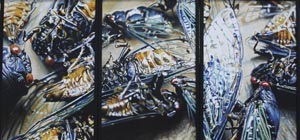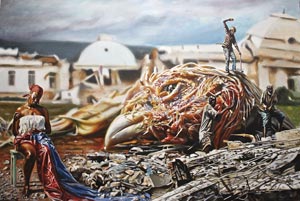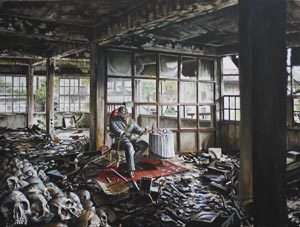Michael Elliott, known as Flyn, is part of a new generation of Jamaican artists that can be defined by its desire to create spaces for a creative practice linked to global concerns and concepts arising from the daily confrontation with reality. Often trained in domestic and foreign educational institutions, this generation members have developed a work that reflects how the frequency and intensity with which ideas and people move in the West Indian space have changed. Therefore close to the community that Chris Cozier referred to as "digital natives", they have introduced in the space of national museums and galleries a language just referential, full of tracks, including the reference to the immediate environment, but also stories of travels made or to be made, news fragments, images debris captured from the communication flows that use the Internet as a base.
Flyn production is marked by an oscillating distance between the represented reality and the pictorial composition. Animals, people and places are, therefore, a reflection of scenarios captured by the artist himself, but also and in equal measure, dreamlike compositions. The game between realism and surrealism, and the use of photography as a working paper prior to painting, are determining at the moment to give the Flyn’s work the appearance of known unreality.
A second section of interest is determined by the thematic aspect. The desolate landscapes that serve occasionally as scene, testify both the political and social conditions that lie behind a decadence atmosphere as the possibilities of this in a dystopian future. This is the case in The Trillonaire, showing the Zimbabwe president Robert Mugabe sitting on a red felt chair placed on a carpet of the same color, all in a destroyed building filled with skulls. Annie Paul has put the work in the context of the artist’s trip to Suriname, bringing it closer to the production of Marcel Pinas (1), rather than the specific location, however, the roundness of the image is cared, as well as its evocative, unsettling ability, which approximates the set to the dystopia field.
 Flyn works the painting from a hyperrealism that uses photography as a working material and which ends up offering details that speak of a violent, degraded reality, where there are common firearms, dead animals, broken dolls, toy soldiers or skulls that make up a gloomy and macabre imaginary, close and yet alien to the immediate reality.
Flyn works the painting from a hyperrealism that uses photography as a working material and which ends up offering details that speak of a violent, degraded reality, where there are common firearms, dead animals, broken dolls, toy soldiers or skulls that make up a gloomy and macabre imaginary, close and yet alien to the immediate reality.
This interview is presented as an observatory located between the two temporal spheres between which Flyn's works move; thus, while it intends to determine the role of utopia and dystopia in their imaginary shaping, it seeks to address a specific context analysis that the artist shares with many other Caribbean creators. His voice will be useful not only at the time to unravel the fantastic "crime scene" proposed on each canvas, but also in a broader sense, to propose a review of the practice of painting in the Caribbean space that would include the possibility of a social and political criticism transcending the recourse to the direct expression of violence.
When did you make up your mind to start painting?
My interest in art emerged from childhood, when I was about six or seven years. At that time I did not think of it as a profession, but I was considering it pretty much... At home I have always been surrounded by interesting things that could be interpreted in a two dimensional plane. I used to look at the environment around me, look at books and magazines, and even get closer to the television’s world, and from all of this was born my inspiration for the creations of that time. It just became a habit: I took an object and began to draw it. I was a very imaginative child, I felt like representing tremendously surreal scenes, first using crayons, markers and sometimes pastels. The watercolors and acrylics came years later.
It was then, in high school, when it came the determinant time to decide in making art a career. I did not know at the time what means to use, whether it would be sculpture, painting, photography or graphic design. I always said that the answers would come whit time. So I went to high school there and I finished it very well in art. Then I attended the Edna Manley Visual Arts School and there I decided I would paint, so I developed different techniques over the years, both in abstract and figurative images. I did not know yet what identity would fit my paintings, what would they be about, or what technique I would use, if realism or impressionism. The fact is that I studied many genres and I experienced in my early years. During art school my interest in photography was further developed by finding ways of conceiving compositions, and trying to see the issue differently: instead of taking a picture of an object following a usual perspective or method, I tried to go into and to find an angle not seen by others.
I've always been interested in the culture and politics philosophy, and what leads the human being to do what he does; the different issues that affect people, natural disasters and the climate change are also taken into account. Every time I hear on the news that something is going on I wonder how could I use the "journalistic intuition" through art, and well, I think this question has become more evident in my work in recent years.
In the first years after art school I painted images that were interesting, but in many cases they had no voice, I was just painting for painting, and it became repetitive after a while. This does not mean that I would not assume traditional elements in my work, but I want to do a traditional art with a more cognitive role. The atmosphere is very important in my work, and that’s why a made paintings like the ones in the railway series, for example, which I began in 2002, and to which I return again and again because every time I visit the switchyard at Kingston center I just travel back in time, to what Jamaica was and to what we had achieved in that time.
 What artists have influenced you?
What artists have influenced you?
During art school I turned my attention to Andrew Wyeth, by the structure of its content and its composition as well as the intensity of the psychological element in creating environments. Another artist who had considerable influence on me was Salvador Dalí, ‘cause I like the way he uses symbolism to create his images. Surrealism is also important, for the many interpretations it can arouse from the same work.
I look at some others attentively: Richard Estes, Hieronymus Bosch. I am also aware of several Caribbean artists: Albert Huey, Roberta Stoddart. Judy Ann MacMillan is also present, particularly for her landscape paintings.
Why did you become interested in realism? How do you explore it in your work?
I think that photography had largely to do with my interest in realism, and the content that I want to represent. The environment I want to show largely depends on how much realistic can the result be: the lights, textures, and those painting elements for which I have always been attracted to... Photography gives you the opportunity to examine more closely, to a deeper level that the one you normally would observe. For example, I painted a work named The Zygote Nest which shows some red peas germinating in a bottle, and I came very close to these peas rather than turn away and see them as such. This vision changes radically the idea, beyond the peas' growth I’m exploring ideas about reproduction or the representation of groups and their conflicts. Of course, there are many people who questions, why a realist painter paints from a photograph? Why not leave it as such? And my answer to that is that photography is part of the process, is the artist's point of view. To me the picture is not the end: it facilitates the end, which is painting; the camera is just a tool, in the same measure as the brush is.
When did you start combining realistic and surreal themes in your work?
That's a very good question. When I was little, when I was a kid doing imaginative compositions; I remember a work I did when I was about six or seven years, I cannot remember when exactly. I drew a picture of angels coming down from heaven and all of them had guns in their hands, they fired in battle, there were demons... I guess I can say that that was one of my first steps; somehow I decided to make a surreal drawing, though I didn’t know at that time what surrealism was. I saw him almost as a humorous work, as would most of the kids at that age.
Over the years I had occasionally conceived pieces with that surreal basis, because imagination is very powerful and even when I'm finishing a painting, with all the elements already configured, sometimes the mind wants to go further with the idea, and to introduce something that would be impossible in reality. Sometimes I give total freedom to my mind, and in those cases the original painting becomes, as it goes, in something else. What emerges spontaneously can be on a topic or subject more interesting than the original; it can fit into a bigger picture and be more sharp and irreverent, so I include it.
 One example is the piece called The Trillionaire. At first I considered showing the empty room, in a disrepair state, but when I was about to paint it I realized that I could turn this into something better. Usually that happens when there are current events, when I hear something on the news, when I read an article. It may be an article about the Zimbabwe situation and at about the same time I’m about to make a painting; and it's like what I’ve read in the article or what I've seen on TV get inside the painting and became part of it. My fuel comes from what happens in society, and over the years it will be even more on that. I believe that artists have a role to play in civilization, because we are the last defense line in terms of telling what have happened in a story, in a country or a community. The reason why we know so much about life in ancient Egypt is because their artists left a brief overview on the walls, the tombs, in the palaces. They, in fact, painted and sculpted life as it was back then, and thus we can understand more clearly what was happening. What if they had not do it? It is important that these newspapers’ commentaries about our existence "remain"; there is also the camera as support, because I have the possibility of going to different places, and when I see something interesting is happening I can "save" an image as a reference. Internet also makes the world smaller, so I can grasp what is happening from photographs, texts or videos.
One example is the piece called The Trillionaire. At first I considered showing the empty room, in a disrepair state, but when I was about to paint it I realized that I could turn this into something better. Usually that happens when there are current events, when I hear something on the news, when I read an article. It may be an article about the Zimbabwe situation and at about the same time I’m about to make a painting; and it's like what I’ve read in the article or what I've seen on TV get inside the painting and became part of it. My fuel comes from what happens in society, and over the years it will be even more on that. I believe that artists have a role to play in civilization, because we are the last defense line in terms of telling what have happened in a story, in a country or a community. The reason why we know so much about life in ancient Egypt is because their artists left a brief overview on the walls, the tombs, in the palaces. They, in fact, painted and sculpted life as it was back then, and thus we can understand more clearly what was happening. What if they had not do it? It is important that these newspapers’ commentaries about our existence "remain"; there is also the camera as support, because I have the possibility of going to different places, and when I see something interesting is happening I can "save" an image as a reference. Internet also makes the world smaller, so I can grasp what is happening from photographs, texts or videos.
In your paintings the scale and size of the objects and characters seem to play an important role. How do you conceptualize these elements?
Sometimes I have no answer to that point. What I do think when I look at an image, for example, is what effect it would have if it were to a greater or lesser degree in relation to another.
I am interested in large formats as they give me some freedom to really "move" the painting, to move the brush. When I work in small works my base is that these works deserve a more intimate relationship with the viewer, a close bond involving rapprochement and understanding. However, my style tends to the large-scale, mostly large format paintings because I like to give prominence to "small" issues or elements, sublimate the miniscule in huge images; it’s like taking an insect and make it monumental, and that way explore the image to the abstraction, deconstructing it in many more dimensions than the ones it has. If I would do so on a scale not much larger as you normally would see it, then you tend to look at it as such and then you continue your way. But I think you're saying much when you change the scale and then you do not see a wing just like a wing (The June Fellowship, for example), but you can see each item as part of a larger issue or context.
When you represent damaged buildings and pictures of this sort... could it be a way to remember the passage of time or is it also on some sort of dystopian future?
I'm glad you brought it up, because much of my work is the representation of the old... with time it allows people or encourages people to reflect on how certain things were and compare them with their current state. We know that the future is more important than the past, but sometimes in order to make the future better, you have to understand the past. And this is one of the mainstays in many of my pieces, and is one of the reasons why I painted the railways series, because it reminds us what we used to achieve and what we can still achieve "if we play our cards right."
In the two years before I graduated from the Art School I developed a group of works consisting of worn out walls or where the paint had come off, or rooms damaged by the passage of time that looked like they were falling apart... They were almost like a metaphor of the human condition: man created these spaces, and the story of his own development is which has turned this place into what it is now. In many aspects is not different from what happens in History, which determines how we evolve, the way we become more peaceful, more violent or more generous. There are many adjectives that can be applied to people, but people change over time as they age. Similarly, the objects will change, it depends on what happens.
Related Publications

How Harumi Yamaguchi invented the modern woman in Japan
March 16, 2022












